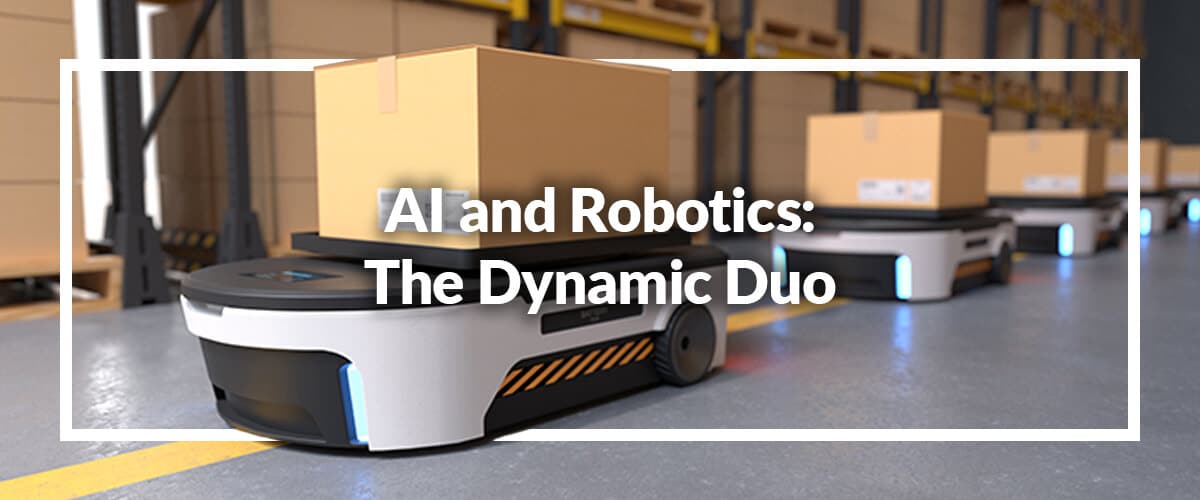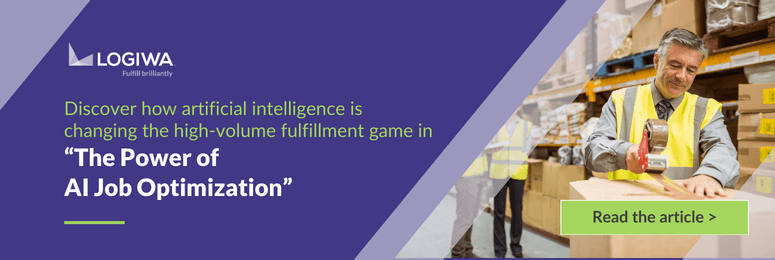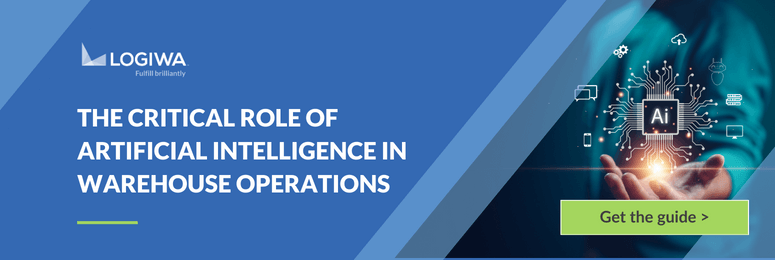Answering the Demand for High-efficiency Fulfillment
In today’s fast-paced ecommerce world, the role of warehouse automation is more important than ever. It represents the pinnacle of efficiency and cutting-edge innovation—helping set new competitive benchmarks with each passing year.
Artificial Intelligence (AI) and robotics are at the forefront of this revolution. Together, these technologies are pushing the boundaries of modern fulfillment into a new era.
This blog delves into the benefit of combining AI and robotics within the realm of warehouse operations. We will explore how this dynamic pair is changing warehouses and setting higher standards for the future of logistics.
Key Takeaways
- AI’s data-driven insights and robotics’ physical capabilities come together to streamline high-volume fulfillment and the efficiency of warehouse operations.
- AI-driven warehouse management can increase warehouse productivity by 38% and warehouse efficiency by 58%, ensuring 93% of orders ship within 24 hours.
- AI-powered robotics not only improve operational efficiency but also promote improved safety, order accuracy, scalability, cost-savings, and more.
- Industry leaders like Amazon are pioneering the use of AI and robotics, setting a precedent for the future of warehouse automation.
Contents
- How AI Technology is Changing Fulfillment Operations
- The Power of Combining AI and Robotics in Warehousing
- Advantages of Integrating AI with Robotics
- Industry Leaders Are Investing in AI and Robotics
- Future of AI-driven Robotics Technology
- The Role of WMS and FMS Solutions Uniting AI and Robotics
- Leading the Way in Warehouse Automation: AI and Robotics with Logiwa IO
- FAQs Related to Artificial Intelligence (AI) and Robotics
How AI Technology is Changing Fulfillment Operations
When it comes to ecommerce fulfillment, AI is now being used to improve supply chains and enhance a growing number of fulfillment processes. From optimizing inventory levels to directing employees on the warehouse floor, AI is doing more than just reshaping logistics operations; it’s revolutionizing them.
With the ability to quickly ingest and analyze large amounts of data, AI ensures B2B and DTC operations achieve peak efficiency and continue to improve. When paired with robotic systems, AI helps warehouses and fulfillment centers become even more competitive.
Combining AI and Automation
Combining AI and automation technology promotes smart, data-driven processes that dramatically increase warehouse efficiency and order accuracy. With advanced machine learning capabilities and ability to solve complex problems, AI can drive positive results in a number of ways:
Improve fulfillment workflows by eliminating and circumnavigating bottlenecks
- Predict inventory needs, inform re-ordering points, and improve replenishment processes
- Optimize warehouse layouts for faster putaway and picking processes
- Enhance labor planning and drive employee activity for better labor efficiency
- Safeguard operational integrity by analyzing real-time activity throughout your fulfillment network
Modern fulfillment management systems (FMS) like Logiwa IO have already incorporated AI-driven features for these reasons. In fact, we’ve proven having AI-driven features like AI job optimization transforms logistics. Results from our solution have shown that AI-driven warehouse management can:
- increase productivity by 38%
- increase efficiency by 58%
- Ensure 93% of orders ship within 24 hours
The Power of AI and Robotics in Warehouses
Integrating AI with robotics technology takes the benefits of AI to the next level. It creates a synergy that extends warehouse automation capabilities and leads to more efficient fulfillment operations.
For example, while AI predicts demand and optimizes stock levels, warehouse robots can physically streamline the movement of inventory for a more effective process. As another example, autonomous mobile robots (AMRs) and automated guided vehicles (AGVs) can be driven by AI-enhanced algorithms. As a result, they can pick, sort, and pack items for faster, more accurate fulfillment results.
Using AI and robotics together helps ensure operations flow continuously at optimum efficiency. Moreover, they ensure a safer, better-automated work environment where human employees can focus on a variety of value-adding tasks. But the benefits don’t end there.
Advantages of Integrating AI with Robotics
In addition to freeing up employees from hazardous tasks and optimizing warehouse efficiency, AI-powered robots offer a number of other advantages:
- Increased Productivity: AI algorithms optimize robot tasks for speed and efficiency, leading to a substantial increase in throughput using your existing resources.
- Enhanced Order Accuracy and Operational Precision: AI-driven robots eliminate human error during tasks like picking, packing, and sorting. This leads to smoother shipping operations and accurate, on-time deliveries—driving customer satisfaction and fewer returns.
- Scalability of Operations: AI and robotics can help you quickly adapt to changing demand, especially when it comes to meeting labor requirements. Knowing when to deploy additional robots, for instance, helps you stay flexible and scalable.
- Data-Driven Decision Making: AI provides insights that empower you to strategically upgrade your operations, including how to best use your robots. For example, AI can analyze historical order data to predict peak seasons and schedule robots more effectively.
- Energy Efficiency: AI-driven robots can optimize their paths and operational strategies to minimize energy usage, contributing to more sustainable operations.
- Real-Time Monitoring and Control: AI enhances real-time tracking of operations and problem-solving if issues arise. This makes it easy to adjust and control the use of high-efficiency robots at a moment’s notice.
- Reduced Downtime: Predictive maintenance powered by AI can forecast robotics equipment failures before they occur, reducing downtime and maintenance costs.
- Cost Reduction: Automation reduces labor costs and AI ensures all forms of automation are working at maximum efficiency—including robots. This can lead to savings in energy and operational expenses.
By harnessing the power of AI and robotics, your warehouses and fulfillment centers can significantly improve your operations. This helps you continue to drive innovation and stay ahead in the competitive world of ecommerce and logistics.
Industry Leaders are Investing in AI and Robotics
Companies like Amazon are paving the way for future advancements in warehouse automation. As an industry leader, the company is setting the bar by investing heavily in AI and robotics.
Amazon not only utilizes a variety of smart robot designs to maintain its competitive fulfillment standards; it has redesigned its fulfillment centers and logistics network to leverage the full potential of robotics. The ecommerce giant has invested in the development of humanoid robots—ones capable of performing increasingly complex tasks. It’s also reinforcing the use of industry-changing AI capabilities.
According to WIRED, 75 percent of all Amazon items are handled by robots at some point in the fulfillment process. This significant integration of robotics in Amazon’s operations shows the transformative power of AI and robotics in the fulfillment industry. It is also setting a benchmark for all operations to follow suit.
Future of AI-driven Robotics
Looking ahead, the integration of AI and robotics in warehouse automation is expected to continue its upward trajectory. This evolution will likely bring more sophisticated AI algorithms and advanced robotic technology like computer vision, further refining and enhancing warehouse operations.
As AI becomes more adept at learning and adapting to different scenarios, we can expect smarter, more intuitive systems capable of handling complex tasks with minimal human intervention. For instance, future AI systems may predict fluctuations in demand with greater accuracy. This will enable robotics fleets to adjust proactively. This could also lead to instantaneous resource reallocation, better predictive maintenance, and dynamic task assignment to robots based on real-time data analysis.
Robotics advancements will include more agile and versatile robots. Future robots could perform a wider range of tasks, from intricate item handling to navigating complex warehouse environments on their own.
Challenges and Considerations
Adopting AI and robotics in warehouses is not without its challenges. Implementation can be complex and costly, and there are ethical considerations regarding workforce displacement. However, with strategic planning and a focus on upskilling the workforce, these challenges can be effectively navigated.
As companies like Amazon continue to invest and innovate in this field, the future of warehouse automation looks toward an era of smarter, more adaptable, and highly efficient operations. This evolution is not just about replacing manual tasks but transforming the entire supply chain into a more responsive, customer-centric, and resilient system.
The Role of WMS and FMS Solutions Uniting AI and Robotics
Warehouse Management Systems (WMS) and Fulfillment Management Systems (FMS) play a critical role in uniting AI and robotics for advanced automation. These platforms facilitate the integration of these technologies. Together, they act as the operational hub of a warehouse, orchestrating AI algorithms and robotics activities to optimize the efficiency of fulfillment processes.
AI-powered systems collect and analyze data on stock, orders, and robot performance, acting as data hubs. They use AI to predict demands and optimize goods placement, ensuring preparedness and minimizing downtime. These systems direct robotic tasks based on real-time priorities.
These platforms also enable rapid adjustments in response to changing warehouse conditions to maintain continuous fulfillment operations. They offer vital analytics for strategic decision-making, influencing process improvements and resource management.
Moreover, the integration of these systems with robotics improves accuracy in inventory management and order fulfillment. Guided by AI, robots execute tasks with minimal errors, to boost the reliability of warehouse operations.
Leading the Way in Warehouse Automation: AI and Robotics with Logiwa IO
AI and robotics have forever changed the world of warehouse automation, offering unparalleled efficiency, safety, and productivity. In this rapidly evolving environment, these technologies are not just an advantage but a necessity to stay competitive.
Fortunately, AI-driven fulfillment management systems (FMS) like Logiwa IO are built to make embracing AI and robotics easy. Our platform is designed to simplify the integration of robotics into your warehouse operations. It also comes pre-built with AI-driven fulfillment features.
By choosing Logiwa IO, you are not only adopting advanced technology but also partnering with a leader in warehouse innovation. We built our solution to be user-friendly and configurable to align with your long-term, real world operational needs. Learn more by visiting: www.logiwa.com/why-logiwa.
FAQs Related to Artificial Intelligence (AI) and Robotics
What impact does artificial intelligence (AI) have on robotics?
Artificial Intelligence (AI) significantly enhances the capabilities of robotics, enabling them to perform complex tasks with greater precision and autonomy. By integrating AI, robots can learn, adapt, and make decisions based on data analysis, leading to more efficient and intelligent automation in various applications.
How do AI and robotics improve warehouse efficiency?
AI and robotics streamline warehouse operations, reduce manual errors, and increase speed and accuracy in fulfillment processes. By automating repetitive and labor-intensive tasks, they allow human workers to focus on more strategic activities. Additionally, AI-driven analytics can optimize warehouse layout and inventory management, leading to further efficiency gains.
Are jobs at risk due to the integration of AI and robotics in warehouses?
While some roles may evolve or change, the integration of AI and robotics also creates new job opportunities that require upskilling workers. These technologies often lead to the creation of more specialized positions, such as system operators and maintenance technicians, requiring new skill sets. Furthermore, this transition can improve job quality and safety for warehouse employees, as AI and robotics take on more physically demanding or repetitive tasks.
Can small to mid-sized businesses benefit from AI and robotics in their warehouses?
Yes, even smaller businesses can benefit from AI and robotics. These technologies can be customized for smaller businesses, helping them use resources efficiently and compete better against bigger companies. Additionally, AI and robotics can provide valuable insights into consumer trends and inventory management. This is essential for the growth of small to mid-sized businesses.
How is Computer Vision Transforming Automated Storage and Retrieval Systems in Warehousing?
Computer vision, powered by deep learning algorithms, enables a wide range of applications, from guiding robotic arms for precise picking to enhancing autonomous vehicles for efficient material transport. This technology, integrated with speech recognition, allows for more intuitive interaction with systems, increasing the versatility of warehouse automation.
The power of AI, user-centric design, and true cloud infrastructure. Logiwa IO elevates fulfillment operations with intuitive processes, scalability, and real-time data access.
Warehouse Management
Modern digital WMS powers a modern fulfillment experience







